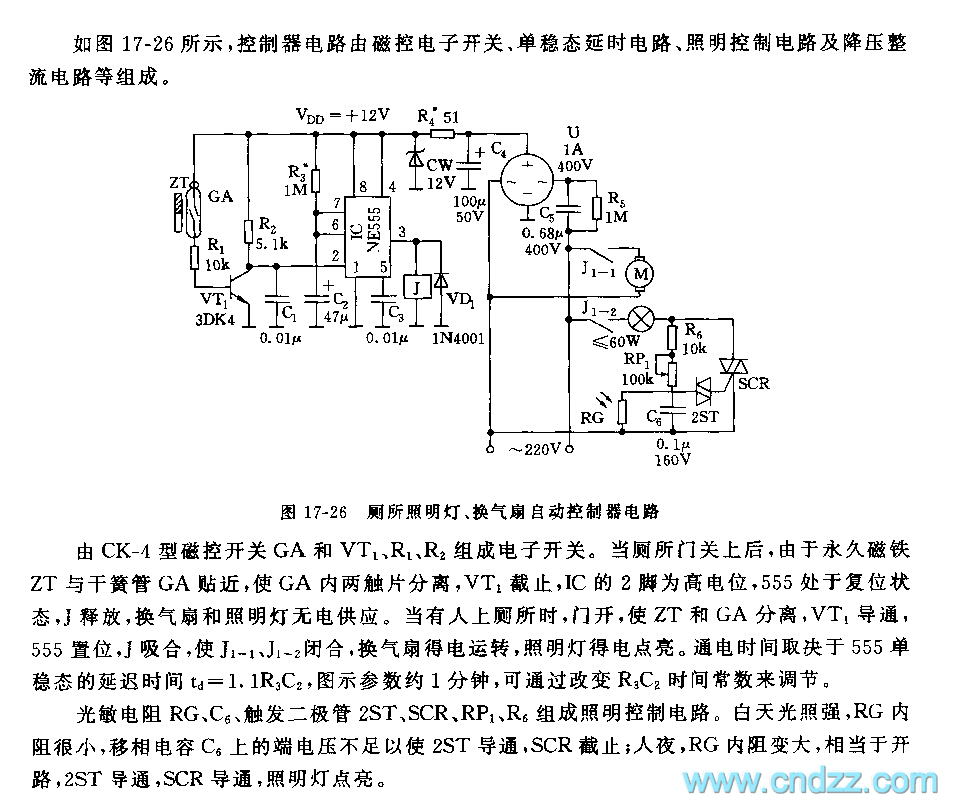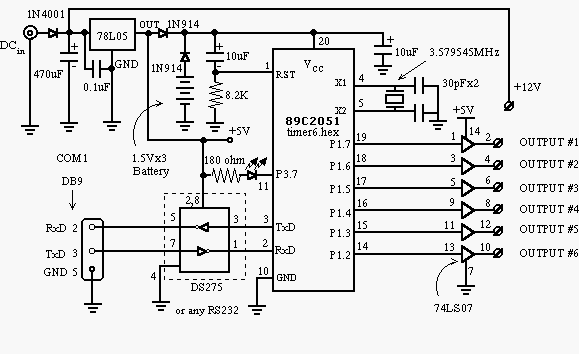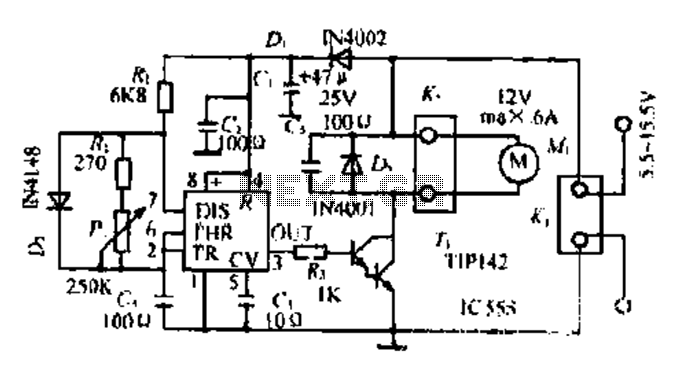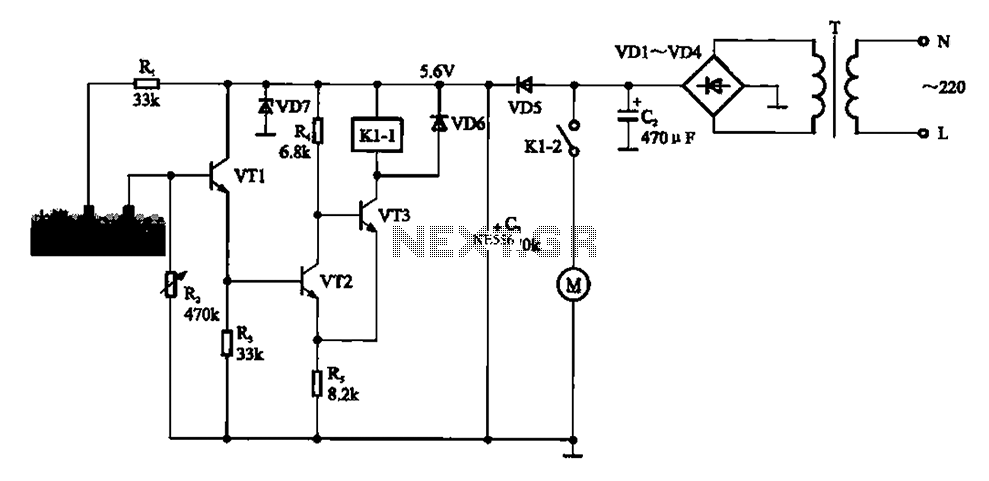
Combustible gas alarm circuit diagram 2 7806 KD28
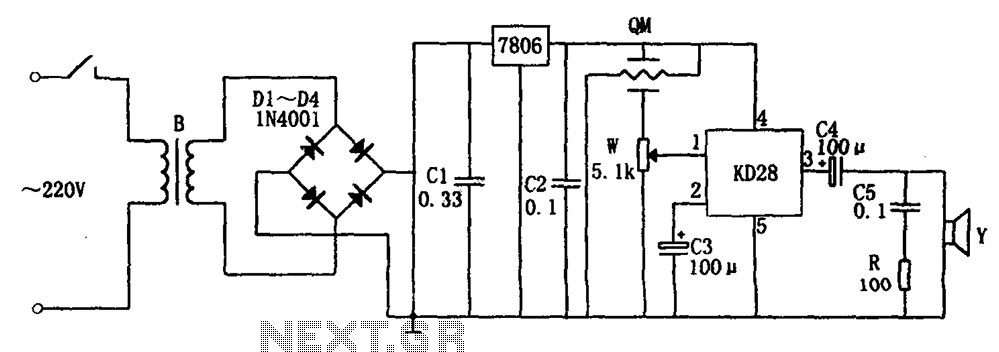
The system includes a gas-sensitive sensor element QM (type QM-N5), a buck rectifier, and regulator circuits, integrated circuits KD28, a speaker Y, and other components. The buck regulator circuit features a transformer rectifier and a bridge rectifier comprising diodes D1 to D4, as well as capacitors C1 and C2, and an integrated voltage regulator (7806). During operation, an adjustment potentiometer (W) is energized for one minute. When the air is clean, the corresponding resistance value of QM is high, leading to a lower pressure on W, which allows the KD28 to reset, preventing the alarm from triggering. However, when flammable gas comes into contact with QM, its resistance value decreases, resulting in a higher pressure on W, which activates the KD28. This, in turn, drives the output to the speaker, generating an alarm signal. Once the gas dissipates, the circuit returns to normal operation.
The gas detection system is designed to monitor the presence of flammable gases in the environment. The core component is the gas-sensitive sensor (QM-N5), which operates based on changes in resistance in response to gas exposure. The sensor is connected to a buck rectifier circuit that efficiently converts the input voltage to a lower output voltage suitable for the integrated circuits and other components. The buck regulator utilizes a transformer and a bridge rectifier configuration (D1-D4) to ensure a stable power supply, while capacitors C1 and C2 filter out voltage ripples, providing a smooth DC output.
The integrated voltage regulator (7806) maintains a constant output voltage of 6V, essential for the reliable operation of the KD28 integrated circuit, which is responsible for processing signals from the gas sensor. The adjustment potentiometer (W) allows for calibration of the sensor's sensitivity, enabling the user to set the threshold for gas detection. Initially, when the environment is free of flammable gases, the high resistance of QM results in a low voltage at the input of the KD28, keeping the alarm system inactive.
Upon detecting flammable gas, the resistance of QM decreases significantly, causing an increase in voltage across W. This change triggers the KD28 to activate the output, which energizes the speaker (Y) to emit an alarm sound, alerting individuals in the vicinity. The system is designed to revert to its normal state automatically once the gas concentration falls below the detection threshold, ensuring continuous monitoring without manual intervention. This gas detection circuit is suitable for various applications, including industrial safety systems, home gas leak alarms, and environmental monitoring setups. As shown in FIG alarm by a gas-sensitive sensor element QM, buck rectifier and regulator circuits, integrated circuits KD28, speaker Y and other components. Gas-sensitive senso r element QM is QM-N5 type. Buck regulator circuit by a transformer rectifier and B, the rectifier bridges D1 ~ D4, C1, C2, integrated voltage regulator 7806 and other components.In operation, the adjustment potentiometer W, so energized for 1 minute. When the air is clean, QM corresponding resistance value is large, the partial pressure of the small W, so that the KD28 reset the alarm does not occur.
When flammable gas when in contact QM, QM corresponding resistance value is small, the pressure on the larger points W, so that the KD28 set, 3 feet high output speaker promoting work, an alarm signal. After the gas leaves the circuit will resume normal operation.
The gas detection system is designed to monitor the presence of flammable gases in the environment. The core component is the gas-sensitive sensor (QM-N5), which operates based on changes in resistance in response to gas exposure. The sensor is connected to a buck rectifier circuit that efficiently converts the input voltage to a lower output voltage suitable for the integrated circuits and other components. The buck regulator utilizes a transformer and a bridge rectifier configuration (D1-D4) to ensure a stable power supply, while capacitors C1 and C2 filter out voltage ripples, providing a smooth DC output.
The integrated voltage regulator (7806) maintains a constant output voltage of 6V, essential for the reliable operation of the KD28 integrated circuit, which is responsible for processing signals from the gas sensor. The adjustment potentiometer (W) allows for calibration of the sensor's sensitivity, enabling the user to set the threshold for gas detection. Initially, when the environment is free of flammable gases, the high resistance of QM results in a low voltage at the input of the KD28, keeping the alarm system inactive.
Upon detecting flammable gas, the resistance of QM decreases significantly, causing an increase in voltage across W. This change triggers the KD28 to activate the output, which energizes the speaker (Y) to emit an alarm sound, alerting individuals in the vicinity. The system is designed to revert to its normal state automatically once the gas concentration falls below the detection threshold, ensuring continuous monitoring without manual intervention. This gas detection circuit is suitable for various applications, including industrial safety systems, home gas leak alarms, and environmental monitoring setups. As shown in FIG alarm by a gas-sensitive sensor element QM, buck rectifier and regulator circuits, integrated circuits KD28, speaker Y and other components. Gas-sensitive senso r element QM is QM-N5 type. Buck regulator circuit by a transformer rectifier and B, the rectifier bridges D1 ~ D4, C1, C2, integrated voltage regulator 7806 and other components.In operation, the adjustment potentiometer W, so energized for 1 minute. When the air is clean, QM corresponding resistance value is large, the partial pressure of the small W, so that the KD28 reset the alarm does not occur.
When flammable gas when in contact QM, QM corresponding resistance value is small, the pressure on the larger points W, so that the KD28 set, 3 feet high output speaker promoting work, an alarm signal. After the gas leaves the circuit will resume normal operation.


